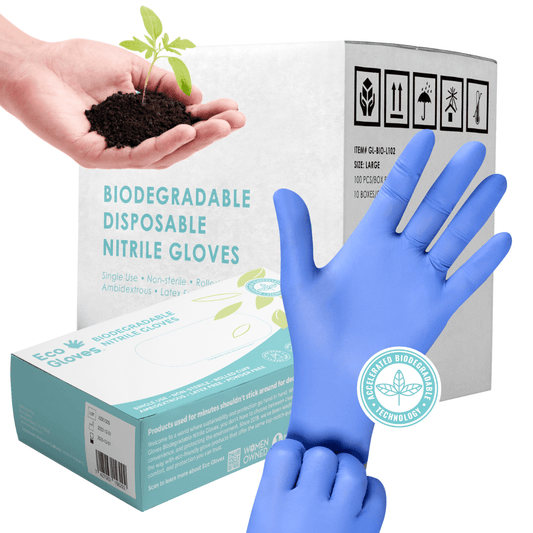How to Select the Right Disposable Gloves for Your Home DIY Projects
Eco GlovesWhen tackling home DIY projects, protecting your hands is just as important as using the right tools. Whether you're painting, gardening, handling household chemicals, or repairing your car, selecting the right disposable gloves ensures comfort, durability, and safety. With various materials and designs available, choosing the right pair can be confusing. This guide explores different types of disposable gloves, their benefits, and the best options for specific home projects.
Topics Covered
- Understanding Disposable Glove Materials
- Choosing Gloves for Specific DIY Projects
- Sustainability and the Future of Disposable Gloves
- Key Takeaways: How to Select the Right Disposable Gloves for DIY Projects
- Frequently Asked Questions About Choosing Disposable Gloves for DIY Projects
Understanding Disposable Glove Materials
Before selecting gloves for your DIY project, it’s essential to understand the different types of materials available. Each material has its own advantages, and knowing the differences will help you choose gloves that best suit your needs.
Nitrile Gloves
Nitrile gloves are a popular alternative to latex gloves and offer excellent durability and resistance to chemicals and punctures. These gloves are commonly used for automotive repairs, painting, and cleaning projects involving harsh chemicals. Unlike latex gloves, nitrile gloves do not cause allergic reactions, making them a safe choice for individuals with latex sensitivities. Their puncture resistance makes them ideal for handling sharp objects, while their chemical resistance ensures protection from solvents, oils, and acids.
Nitrile can be slightly less flexible than latex gloves, however, their durability makes them a great investment for long-term protection in high-risk DIY activities.
Latex Gloves

Latex gloves are known for their superior flexibility and comfort. They provide a snug fit and great flexibility, making them ideal for tasks that require precision, such as painting and detailed craft projects. Latex gloves are naturally biodegradable, making them a more environmentally friendly choice compared to synthetic alternatives. However, some individuals with latex sensitivities may find nitrile or vinyl gloves to be a better alternative.
While latex gloves offer a high level of touch sensitivity, they are not as resistant to strong chemicals as nitrile gloves. They are best used for low-risk chemical exposure DIY projects that require dexterity, such as assembling small components or working with light adhesives.
Vinyl Gloves
Vinyl gloves are a cost-effective option for light-duty tasks, such as handling food, gardening, or basic cleaning. They are less durable than nitrile or latex
but are suitable for short-term use where chemical exposure is minimal. Vinyl gloves are latex-free, making them a suitable option for individuals with latex allergies. However, they do not offer the same level of durability or chemical resistance as nitrile gloves.
Vinyl gloves work best for tasks that require a temporary barrier against dirt and mild irritants, such as light cleaning or food preparation. Since they are relatively inexpensive, they are a budget-friendly choice for single-use applications.
Polyethylene (PE) Gloves

Polyethylene gloves are typically used for food handling but can
also be useful for light painting and gardening tasks where minimal
protection is needed. They are loose-fitting and designed for quick,
disposable use. Because of their low durability, they are best suited for
situations where frequent glove changes are necessary.
While they provide a barrier against contaminants, they are not suitable
for handling sharp objects or harsh chemicals.
Biodegradable Nitrile Gloves
Biodegradable nitrile gloves offer the same trusted protection and
durability as traditional nitrile gloves, making them an excellent
choice for a variety of home DIY projects. Like their conventional
counterparts, these gloves provide a dependable barrier against chemicals, oils, solvents, and pathogens—ideal for tasks such as automotive repairs, heavy-duty cleaning, and paint jobs involving strong compounds. Their puncture resistance makes them suitable for
handling tools and sharp materials safely.
What sets biodegradable nitrile gloves apart is their enhanced environmental benefit. Thanks to an innovative organic bio-agent added during manufacturing, these gloves attract microbial activity in landfill conditions, accelerating their breakdown without compromising performance or shelf life. This means you can tackle tough DIY projects with confidence—while making a more sustainable choice for the planet. If you're looking for heavy-duty protection without the environmental guilt, biodegradable nitrile gloves are a smart, eco-conscious upgrade.
Choosing Gloves for Specific DIY Projects
Each DIY task requires different levels of protection and comfort. Choosing the right gloves for the job ensures efficiency, safety, and long-lasting performance.

Painting Projects
Painting requires gloves that provide both protection and flexibility. Nitrile gloves (standard or biodegradable) are the best choice as they resist solvents found in paints, stains, and varnishes. Their snug fit ensures better grip and control when handling brushes or spray equipment. Latex gloves can also be used for painting, but they may degrade when exposed to solvents.
For long painting sessions, consider using thick nitrile gloves to prevent hand fatigue and minimize the risk of paint seeping through. Reusable gloves with a textured grip can also help improve handling and precision.
Gardening and Yard Work
Gardening gloves should protect against dirt, moisture, and minor abrasions while allowing dexterity for delicate tasks like planting. While cotton, polyester, leather, and thick rubber latex gloves would work well for a reusable option, disposable options that also provide better flexibility and dexterity include nitrile and latex. Latex gloves provide flexibility and a snug fit, while nitrile gloves offer better puncture resistance for handling thorny plants or sharp tools. Light weight compostable gloves could also work for light gardening tasks.
For extensive yard work, thick latex or nitrile gloves of at least 6-10 mil are recommended to prevent blisters and skin irritation from prolonged exposure to soil and plant debris. If working with pesticides, nitrile gloves should be used for chemical protection.

Cleaning and Disinfecting
Household cleaning involves exposure to chemicals that can irritate the skin. Nitrile gloves (standard or biodegradable) of 3.5-5 mil thickness offer superior resistance to harsh cleaners, including bleach and ammonia-based solutions. Vinyl gloves can work for mild cleaning tasks but are not recommended for strong chemicals.
Opt for heavy-duty nitrile gloves for deep cleaning projects involving scrubbing, disinfecting, or handling strong cleaning agents. These gloves provide better grip and protection against chemical burns or irritation.

Automotive and Mechanical Repairs
Automotive work exposes hands to grease, oil, and sharp tools. Nitrile gloves of at least 4-8 mil thickness provide excellent protection against these substances and prevent skin irritation from prolonged exposure to motor fluids. They are highly durable and resistant to punctures, making them ideal for mechanics and DIY car enthusiasts.
For working with greasy parts or changing oil, thick nitrile gloves with a textured surface are recommended. They offer a secure grip while providing maximum protection against chemicals and abrasions.

Home Repairs and Crafting
Whether assembling furniture, working with adhesives, or handling minor electrical work, comfortable and dexterous gloves are essential. Latex gloves provide the best flexibility, while nitrile gloves are preferred for projects involving adhesives and solvents.
For woodworking or metalwork, heavy-duty nitrile gloves help protect against splinters and sharp edges. When working with glue, latex gloves are ideal for precision tasks that require enhanced tactile sensitivity.
Takeaways
Choosing the right disposable gloves for your home DIY project is essential for both your safety and the success of the task at hand. Whether you’re dealing with harsh chemicals, sharp tools, or delicate detail work, there’s a glove material that meets your specific needs. Nitrile gloves offer durability and chemical resistance for heavy-duty jobs, while latex gloves provide flexibility and precision for intricate tasks. Vinyl and polyethylene gloves serve as economical solutions for lighter duties. And for those looking to reduce their environmental impact, biodegradable nitrile gloves deliver all the protection of traditional nitrile with the added benefit of enhanced sustainability.
By understanding the strengths and limitations of each glove type, you can make an informed choice that keeps your hands protected and your projects running smoothly—while aligning with your values and priorities.
Sustainability and the Future of Disposable Gloves
Conventional nitrile and latex gloves take years to decompose, contributing to pollution and environmental degradation. Biodegradable alternatives can provide the same level of protection while being more sustainable. Consumers and businesses should consider switching to eco-friendly glove options to minimize environmental harm.
Eco Gloves is committed to providing high-quality, sustainable gloves for all your DIY and professional needs. To shop high-quality thick nitrile, biodegradable, and compostable disposable gloves, and make a responsible choice for your DIY needs!
Key Takeaways: How to Select the Right Disposable Gloves for DIY Projects
-
Match Glove Material to the Task – Nitrile offers superior durability and chemical resistance, latex provides flexibility and precision, vinyl is cost-effective for light work, and polyethylene is best for quick, low-risk tasks.
-
Consider Thickness for Protection – For heavy-duty projects like automotive repairs or yard work, choose gloves at least 4–10 mil thick; for light tasks, thinner gloves allow better dexterity.
- Choose Chemical-Resistant Gloves When Needed – Nitrile (standard or biodegradable) is best for handling solvents, paints, adhesives, and harsh cleaners.
-
Prioritize Comfort for Long Wear – Latex gloves offer a snug, comfortable fit for detailed work, while nitrile provides a balance of comfort and durability for extended use.
-
Opt for Eco-Friendly Options – Biodegradable nitrile gloves provide the same performance as traditional nitrile with faster breakdown in landfill conditions.
-
Select Gloves Based on Project Type – Painting, gardening, cleaning, mechanical repairs, and crafting all have specific glove material and thickness needs.
-
Factor in Allergy Concerns – For latex-sensitive users, nitrile, vinyl, and biodegradable nitrile gloves are safe alternatives.
👉 The right glove choice ensures comfort, safety, and efficiency while reducing environmental impact—especially when you choose sustainable options like Eco Gloves.
Frequently Asked Questions About Choosing Disposable Gloves for DIY Projects
-
Which glove material is best for handling chemicals?
Nitrile gloves—especially heavy-duty ones—are the most resistant to solvents, oils, and harsh cleaning agents.
-
What gloves should I use for painting projects?
Nitrile gloves (standard or biodegradable) are ideal, as they resist solvents in paints and stains while providing a snug, precise fit.
-
Are latex gloves still a good choice for DIY tasks?
Yes, for tasks requiring precision and dexterity, latex gloves work well—just avoid them if you have a latex allergy.
-
What’s the most budget-friendly glove option for light tasks?
Vinyl gloves are inexpensive and sufficient for short-term, low-risk activities like light cleaning or food prep.
-
Can I use compostable or biodegradable gloves for tough DIY jobs?
Yes. Biodegradable nitrile gloves perform like traditional nitrile, offering durability, chemical resistance, and puncture protection, while breaking down faster in landfill conditions.




















